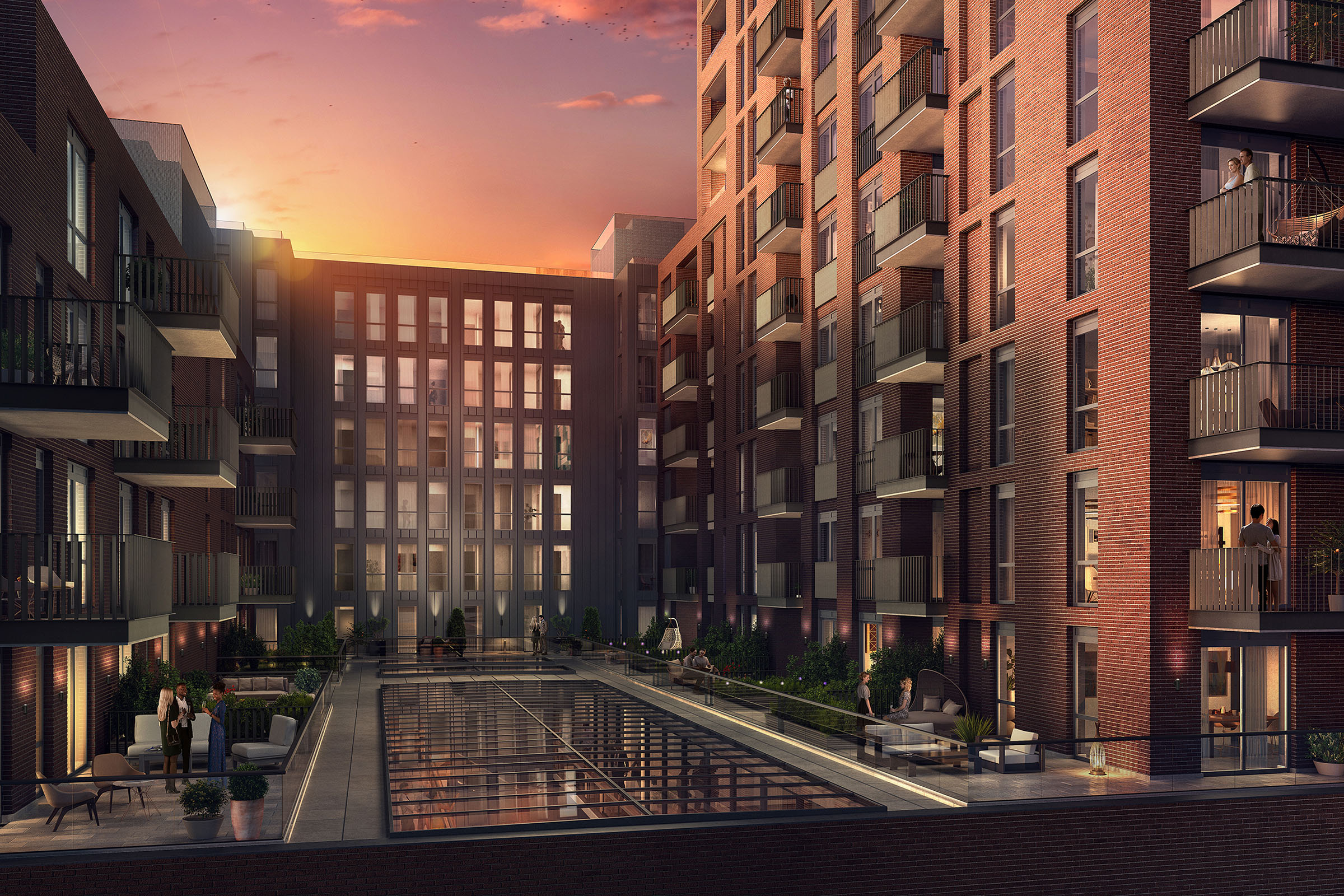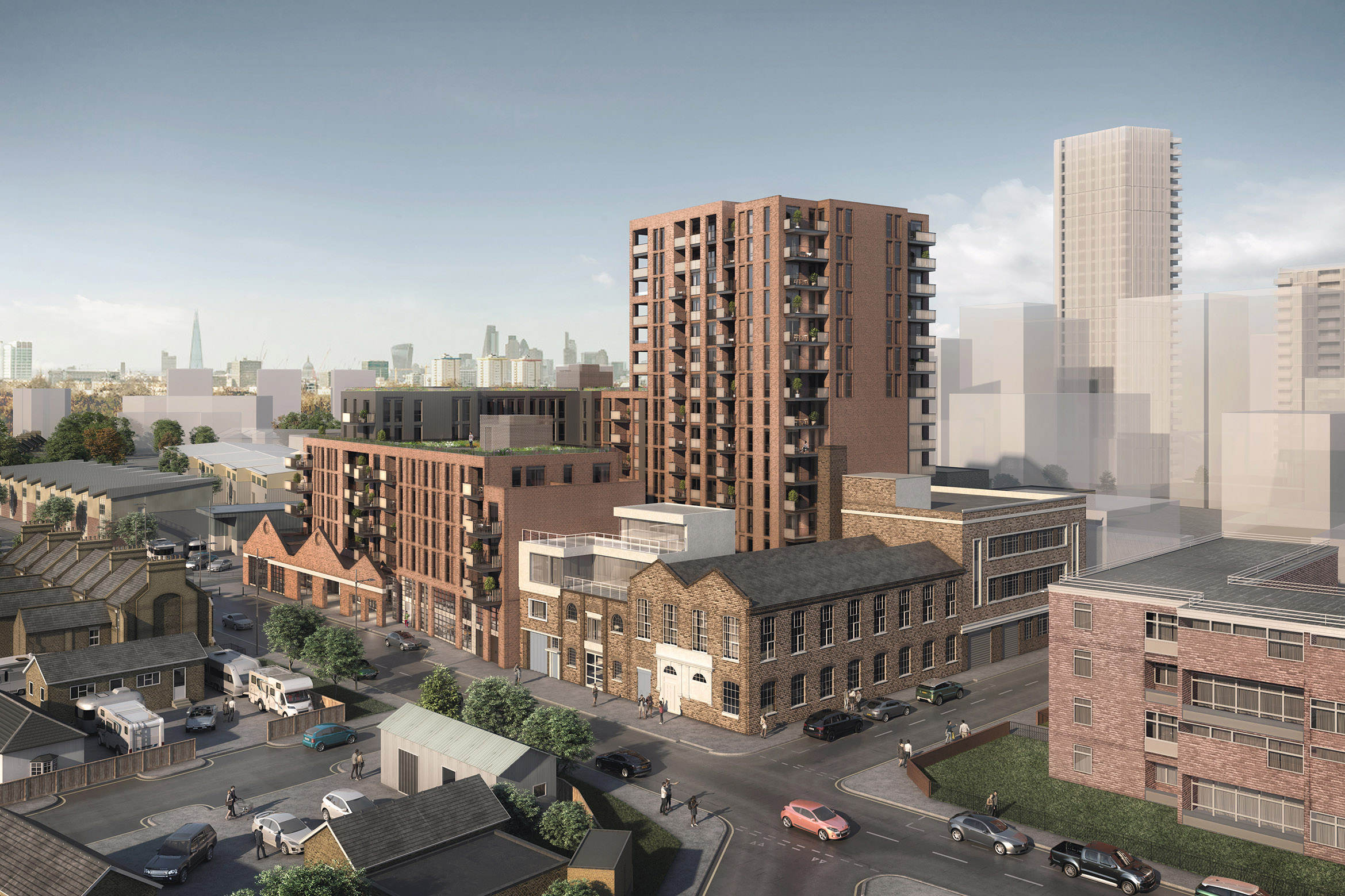
14.11.24
Case Study
Glengall Road demonstrates a cohesive and contextually attuned urban regeneration of Southwark’s rich industrial heritage—one that celebrates complexity, preserves industrial memory, and fosters a seamless coexistence of diverse urban life.
Commissioned by Twenty Twenty Glengall Ltd, HKR Architects conceived the development as a dynamic urban fabric where residential, commercial, and public spaces are interwoven to enhance both liveability and long-term adaptability. Shaped through close collaboration with consultants and stakeholders, the scheme champions material honesty, spatial richness, and a resilient framework for future growth—delivering enduring social and environmental value for the wider community.

The Site
Situated at the junction of Glengall Road and Bianca Road, the 0.44-hectare site occupies a pivotal junction within Southwark’s shifting urban fabric, directly adjacent to Burgess Park and within walking distance of several emerging regeneration zones within the OKR14 Masterplan. Its layered geography and enduring architectural fragments mark Figure 1.6 1952 Plan it as a threshold site—where historical utility and future transformation intersect.
The site reflects a deep industrial lineage, historically tied to the Grand Surrey Canal. Once a vital artery for transporting Figure 1.11 Edison Bell Factory and Council Depot coal and timber, the canal shaped the area’s morphology until its mid-20th-century infill gave way to roads, housing, and green space. The site itself was home to various brick-built sheds for light manufacturing—glassworks, bottling, and packaging—traces of which are retained in the preserved red brick facades and chimney stack.
This transitional landscape is reinforced by its surroundings: low-rise commercial plots to the east and south, awaiting future regeneration. Domestic terraces and community gardens lie to the west, and the planned Surrey Canal Linear Park to the north. In this context, Glengall Road stands not as an isolated plot, but as a pivotal link between old and new, solid and green, memory and renewal.

The Scheme
The architectural strategy for Glengall Road is shaped by a careful reading of urban scale, solar orientation, and the spatial memory of the site. At its core, the scheme adopts a C-shaped massing configuration that frames a generous internal courtyard—anchored by the retained red brick chimney—and establishes a porous relationship with the surrounding streetscape.
The massing responds to context through a calibrated height sequence: starting at five storeys along the park-facing western edge, stepping to six storeys on Glengall Road, rising to eight along Bianca Road, and culminating at thirteen storeys to the southeast. This stepped arrangement respects adjacent neighbourhood scales while marking the site’s civic significance within the OKR14 precinct.
The internal courtyard is conceived not as residual space but as a social hinge—an active centrepiece that invites light into the building’s core, promotes visual permeability, and spatially unites old and new. Commercial frontages at ground level are recessed to maximise daylight and reduce visual bulk at street level, while residential volumes above are carefully arranged to ensure privacy, natural ventilation, and optimal solar access.
Public consultation in 2017 significantly shaped the massing logic and programme distribution. Feedback from over 50 local participants emphasised affordability, architectural quality, and heritage continuity. In direct response, the final scheme retains key historic structures, provides 35% affordable housing, and embeds these priorities into both the spatial composition and material identity of the proposal.
Design Development

Architectural Expression
Material and detail play a central role in mediating between the site’s industrial memory and the aspirations of a residential-led future. The primary façade material is red brick, selected to echo the existing structures on site while grounding the new architecture in familiar language.
Recessed upper floors are clad in dark grey metal, creating a sculptural contrast and breaking down perceived mass. This setback also contributes to a softened skyline, reducing visual impact and lending a more refined profile to the building’s upper edges. Balconies—both inset and bolt-on—feature powder-coated steel balustrades with vertical fins, designed to enhance privacy and introduce a dynamic interplay of light and shadow across the elevations. Juliet balconies and corner units are handled with deep reveals, emphasizing structural clarity and proportion.
Ground-floor commercial spaces are expressed with curtain wall glazing framed in dark profiles, referencing industrial window systems while ensuring permeability and animation along street edges. Lift overruns and rooftop access points are discreetly detailed using expanded metal, maintaining a consistent material vocabulary throughout.

Residential Provision
The residential component of Glengall Road comprises 181 units ranging from studios to three-bedroom apartments, designed to meet high standards of space, comfort, and accessibility. The scheme delivers 35% affordable housing—split 70% social rent and 30% intermediate tenure—in alignment with local policy and in response to community priorities raised during consultation.
A key design objective was to maximise quality of life through daylight, dual aspect, and generous private amenity. 83% of the homes achieve dual aspect layouts, ensuring cross-ventilation, natural light, and spatial depth. The remaining single-aspect units are carefully positioned to avoid north-facing exposure and optimised for thermal comfort and privacy.
Private balconies, garden terraces, and recessed winter gardens are provided for every unit—each contributing to visual rhythm and resident wellbeing. Communal amenity is layered across the development, with two shared rooftop terraces on the 5th and 7th floors, including a children’s play area and dedicated outdoor space for affordable housing residents. In total, the scheme offers over 3,200 sqm of amenity space, fostering a sense of community and supporting long-term liveability.

Everyday Interfaces: Commerce, Landscape, and Community
Glengall Road’s public realm strategy prioritises permeability, material clarity, and social activation. Along its northern edge, the proposal extends the emerging Surrey Canal Linear Park—transforming a former industrial trace into a civic and ecological spine. A new public route connects Glengall Road with the park, enhancing pedestrian movement across the site.
The internal courtyard is both a shared residential amenity and a reinterpretation of the working yard, referencing the site’s industrial past. Landscaped with low-maintenance planting and framed by brick and metal façades, it becomes a semi-public space where old and new intersect.
Entrances are clearly defined for legibility and accessibility, while the courtyard and community room overlook Glengall Wharf Garden—encouraging visual continuity and potential neighbourhood interaction.
Additional amenity is provided via rooftop terraces, while planted edges, seating, and play areas activate the ground level. Integrated landscape elements soften the architecture and enhance microclimate performance. The scheme reimagines the site not as an enclave, but as a connective surface—linking memory and movement, solitude and sociability.


An Ethos of Grounded Transformation
Glengall Road reflects HKR’s approach to regeneration as an act of continuity—where context becomes foundation. Architecture here acts as a medium for dialogue, connecting past structures with present needs and future possibilities. Rather than impose a singular vision, the design draws meaning from the site’s layered identity and frames it as an opportunity for spatial and social coherence.
The project contributes to a broader body of work focused on adaptable neighbourhoods, mixed-use resilience, and civic-minded public realm. Through integrated housing, workspace, and amenity, the scheme balances everyday functionality with architectural clarity, environmental performance, and inclusive access.
By retaining industrial fragments, aligning with civic frameworks, and enhancing permeability, the project offers a grounded but forward-looking model of regeneration. It supports overlap between public and private life while respecting infrastructure, material memory, and social rhythm.
Within HKR’s practice, Glengall Road exemplifies a commitment to building with memory, designing with empathy, and shaping places open to reinterpretation. Continuity here takes the form of purposeful transformation—anchored in place and responsive to change.








